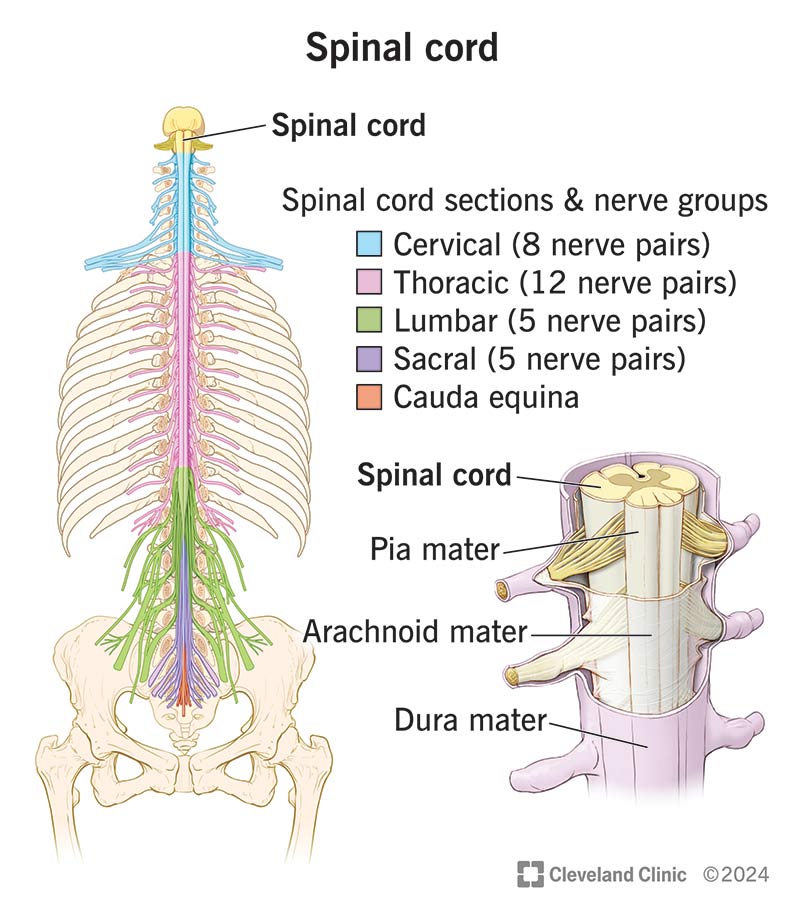Your spinal cord is a tube of tissue. It runs from your brain to your lower back. Your spinal cord carries nerve signals from your brain to the rest of your body and back. These signals help you feel sensations, move your body and keep breathing. Any damage to your spinal cord can affect your movement or function.
Advertisement
Cleveland Clinic is a non-profit academic medical center. Advertising on our site helps support our mission. We do not endorse non-Cleveland Clinic products or services. Policy

Your spinal cord is a cylinder-shaped tube of tissue that runs through the center of your spine, from your brainstem to your lower back. It’s made of nerves and cells that carry messages from your brain to the rest of your body. Your spinal cord is one of the main parts of your nervous system.
Advertisement
Cleveland Clinic is a non-profit academic medical center. Advertising on our site helps support our mission. We do not endorse non-Cleveland Clinic products or services. Policy
Your spinal cord carries nerve signals from your brain to the rest of your body and back. The signals are electrical messages that help almost everything in your body work correctly, including:
Your spinal cord is like a much more important version of the cable that sends and receives your TV signal. Instead of transferring data back and forth about your favorite shows and movies, your spinal cord carries all the messages that help your body function and stay connected to your brain.
Advertisement
Your spinal cord starts at the bottom of your brainstem and runs the length of your spine. It ends in your lower back in a cone shape called the conus medullaris.
Your spinal cord has three areas that match the three sections of your spine:
There are 31 nerves connected to your spinal cord. Thirty of your spinal nerves are pairs (one on each side of your spinal cord), including:
The final nerve is a bundle at the base of your spine called the cauda equina that gives sensation to your lower body.
Your spinal cord is covered in layers of tissue called meninges (just like the ones that surround your brain). These protective tissues include:
The epidural space is between the dura mater and arachnoid mater. It’s where healthcare providers insert epidurals during labor and childbirth.
The subarachnoid space is between the arachnoid mater and the pia mater. Here, cerebrospinal fluid (CSF) provides extra cushioning and protection for your spinal cord. If you need a lumbar puncture (spinal tap), a healthcare provider will insert a needle into the subarachnoid space, remove a sample of your CSF and test it for signs of infection.
Many health conditions and injuries can affect your spinal cord. Because your spinal cord is so important to your whole body’s ability to function, spinal cord injuries and disorders are serious. For some disorders, getting treatment quickly can lower your risk of long-term or permanent complications.
Any injury to your spinal cord can cause severe symptoms in the parts of your body below where the injury happens. Spinal cord damage can cause a loss of bladder control or paralysis.
Common conditions that can affect your spinal cord include:
Advertisement
You can keep your spinal cord (and entire back) healthy by following these general tips:
Your spinal cord and vertebral column are the two parts of your spine. Your spinal cord is a band of tissues, nerves and cells. The vertebral column is a protective layer of bone that protects your spinal cord.
The bones in your vertebral column are called vertebrae (plural of one spine bone, a vertebra). Your vertebrae form a stack that runs from your skull down to your pelvis. There’s a spinal disk between each pair of vertebrae. Disks have a tough outer shell and a gel-like interior. They’re shock absorbers that cushion your vertebrae and spinal cord.
There’s no award for “most important body parts,” but if there were, your spinal cord might be a finalist. It’s the connection between your brain and the rest of your body. Your spinal cord constantly transfers electrical nerve signals to and from your brain to help you move, feel sensations and stay alive.
Advertisement
Conditions and injuries that affect your spinal cord can be very serious, so don’t ignore anything that affects how you can move, feel or control your body. If it’s enough of a difference to make you feel worried or concerned, it’s worth visiting a healthcare provider. They’ll help you understand what’s causing the symptoms, and which treatments you’ll need to manage them.
Advertisement
If you have a neurological condition, you want expert advice. At Cleveland Clinic, we’ll work to create a treatment plan that’s right for you.

Last reviewed on 10/22/2024.
Learn more about the Health Library and our editorial process.